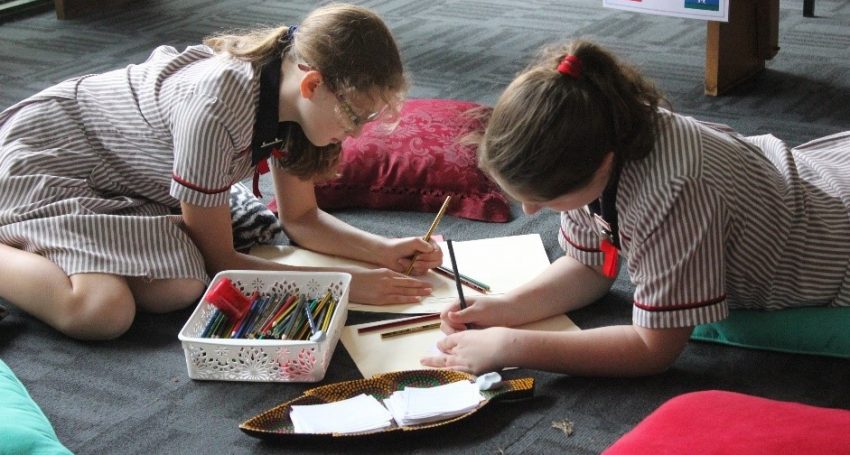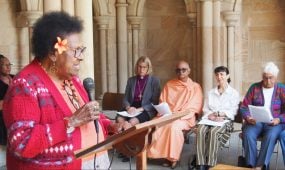Prayer Spaces – a journey worth taking
Reflections
“In the Prayer Spaces framework, ‘space’ can unite mind, body and spirit, as students are positioned in a safe context of quiet and calm, where they can consider the ‘big questions’ of life and faith,” says Vanessa Gamack, Mission and Education Advisor at the Anglican Schools Commission

School students today often face an increasingly stressful journey during their education. Worryingly, Headspace reports of heightened anxiety, stress and depression among our youth, with 70% of youth rating their own mental health as only poor or fair. In addition, young people are leaving their faith and seeking new ways to find meaning and purpose in their lives.
Against this backdrop of wellbeing and spiritual challenges for youth, Anglican schools in Southern Queensland have embraced ‘Prayer Spaces’. While Prayer Spaces may not provide a panacea for all the problems young people face, they may provide a map to help students navigate their way through any troubling or turbulent times at school.
Prayer Spaces support students because they are so much more than a physical area. A ‘Prayer Space’ can be a place to meditate, to breathe, to journal or to relax. The term ‘space’ carries with it the metaphysical dimensions of thought, inquiry, reflection, contemplation and time. In the Prayer Spaces framework, ‘space’ can unite mind, body and spirit, as students are positioned in a safe context of quiet and calm, where they can consider the ‘big questions’ of life and faith. Students have access to the ‘space’ they require to connect with their own spirituality as they embark on their own unique journey of discovery.
There is currently a vision of ‘slow education’ emerging in Australia. Associate Professor Miriam Tanti, Acting Head of the School of Education in NSW and the ACT at the Australian Catholic University (2019, Education Matters) explains that slow education allows for examination and reflection. It fosters creativity and allows for connecting to self, others and place. Slow education involves asking life’s bigger questions to seek clarity and insight. Prayer Spaces have a natural synergy with slow education, where learning flows naturally and according to each student’s own rhythm and pace.
Advertisement
In fact, Prayer Spaces are really like a pathway for students allowing them to wander through their ideas, beliefs, concepts and issues, connecting as needed with others on the way. It could be described as a ‘mini pilgrimage’, with students travelling from one prayer space to another, lingering, learning and listening to their hearts. For some students, this process soothes the soul. For others, it creates questions or demands reflection. Each student is free to have a unique encounter in their own time of solitude. This special journey, facilitated by Prayer Spaces, is completely invitational and often we do not know where the path shall lead.
Prayer Spaces, as we use them in Southern Queensland Anglican schools, have been inspired by the wonderful folk of Prayer Spaces in Schools. The story of how Anglican schools have come to embrace Prayer Spaces really begins with the vision of The Rev’d Susan Crothers-Robertson, who opened our eyes and hearts to this idea in 2014, when she created the first known Prayer Space in Australia at St John’s Anglican College in Brisbane when she was the College’s Chaplain. The Rev’d Susan acknowledges the work of the Christian organisation, 24-7 Prayer as leading the way in the development of Prayer Spaces the UK, more than 10 years ago. Since The Rev’d Susan’s first connection with Prayer Spaces, she has fostered a very close connection between our schools and the Director of Prayer Spaces in Schools in the UK, Phil Togwell. The Rev’d Susan continues to maintain her strong connections with the UK, in part through her administration of the Prayer Spaces in Schools Australia Facebook page. If you want to know anything about Prayer Spaces, The Rev’d Susan is currently working on her doctorate in this area. She is passionate, experienced, energetic and shares generously with everyone who asks for her support! Since discovering the world of Prayer Spaces, The Rev’d Susan has found herself extolling the virtues of Prayer Spaces at a number of conferences in Melbourne and Brisbane. Listening to The Rev’d Susan’s passionate descriptions of the power and the potential of Prayer Spaces has inspired many of her peers to follow suit and introduce Prayer Spaces into their own schools.
Advertisement
Prayer Spaces are non-denominational and welcome all students of all or no faiths. It is this extraordinary inclusivity and ability to meet students exactly where they are in their own faith journey that makes Prayer Spaces so effective in Anglican schools. As Anglican educators embraced Prayer Spaces to provide their students with a spiritual experience, regardless of their own faiths or beliefs, they began to recognise the transformational power of a ‘Prayer Space’ experience. In a safe and non-threatening setting, students can ponder the big questions of life without feeling any expectations, pressure to perform or judgement. Students are exposed to a way of knowing that respect their own personal journeys, allowing for reflection and time to think. Students can journey through the ‘Prayer Spaces’ according to their own needs, interests and desires.
Inspired by the transformational nature of ‘Prayer Spaces’, many schools have adopted this practice and made it work for their own school. Mrs Ingrid McIlwarith, the Religious Education teacher for the Junior School at St Hilda’s School, began by developing wonderful Prayer Spaces in her classroom. Ingrid used her creative flair for design to create themed Prayer Spaces in her classroom. She would often have a group of students queuing at her door at break times, hoping to spend a little time praying, thinking or reflecting in her special Prayer Space. As Ingrid notes, “I find that a few girls really love to come in and chill and reflect.” For Ingrid’s students, Prayer Spaces provide a place of emotional support, where students can pray and find spiritual support when they are in need. The Rev’d Nicki Colledge, an experienced creator of Prayer Spaces, has been known to transform the Chapel at St Margaret’s Girls’ School into a series of Prayer Spaces on many occasions, with both staff and students taking time out to write prayers for one another.
The Rev’d Susan Crothers-Robertson, our resident expert on all things to do with Prayer Spaces, has used the school Chapel, assembly space and the great outdoors to develop a series of Prayer Spaces over the years. Each location was unique, with each evoking a sense of tranquility and inviting students to embrace the peace and connect with their own spirituality. The Rev’d Gillian Moses, from St Aidan’s Girls School in Brisbane, appreciates the way Prayer Spaces allow her students to experience contextual theology. The Rev’d Gillian and The Rev’d Susan both use Prayer Spaces to explore Reconciliation and have created some original ‘spaces’ that were contextual to Brisbane. The Rev’d Gillian says that Prayer Spaces allows her students to explore the stories of engagement between Europeans and the Jagera and Turrbal people, whilst also drawing on Judeo-Christian traditions.
If you have not yet had the joy of developing Prayer Spaces in your school, rest assured that one does not need to be experienced or an expert to embark on the Prayer Spaces journey immediately. The website Prayer Spaces in Schools contains all the information required to prepare you to create Prayer Spaces for your schools’ community. If in doubt, we always recommend you look at the Top Ten Prayer Activities which we have used in schools and in St John’s Anglican Cathedral. We suggest that you follow the structure of having a range of activities so that students are encouraged to send their prayers upwards to God (prayers about the Big Questions of Life), to send their prayers outwards to the world around us, and finally to send their prayers inwards to self.
Related Story
 Video
Video
Prayer spaces at St John's Anglican College
One cannot create Prayer Spaces without developing a few favourites that always seem to resonate with a particular school’s students and teachers. We love Thankful Play Dough, which encourages students to think about their lives and all the things for which they can give thanks. Cardboard Home is a powerful and profound experience for many and develops empathy and understanding as students reflect on the many people who have no home, and possibly no food or family.
Prayer Spaces can reflect current units of work, issues the students themselves feel strongly about or the social and emotional needs of a certain cohort of students. They provide experiential learning at its best and allow students to respond and reflect in a meaningful, relevant and timely way. In using Prayer Spaces, students can explore big issues such as peace, justice, conflict and nonviolence in a deep and profoundly personal way.
If you are interested in seeing your students develop their thinking, their compassion and their own awareness, incorporating Prayer Spaces into your school program may be just the tool you need. A Prayer Space provides students with such a unique opportunity to expand their view of the world because they provide a safe space for students to think, learn, reflect, consider and maybe gain a new perspective. Prayer Spaces allow students to step off the busy roller coaster ride that is school and pause, breathe and unite their mind, body and spirit.
Of course, if you have any questions about Prayer Spaces, the team in Queensland is always available for support and help. Remember, as theologian and philosopher Abraham Joshua Heschel wrote, “Faith is not clinging to a shrine but an endless pilgrimage of the heart.”
May the hearts of your students be blessed by your own Prayer Spaces.





